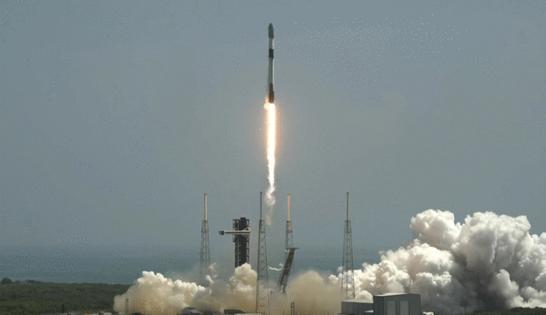SpaceX sends up Space Coast's 50th launch of the year
Published in News & Features
Florida’s 50th launch of 2025 had been planned to be a human spaceflight, but instead it ended up being another batch of Starlink satellites.
SpaceX and Axiom Space remain on hold for any attempt to launch the Ax-4 mission from Kennedy Space Center, which had several options to fly this week, but were stymied by weather and then a liquid oxygen leak on the Falcon 9 booster. They await the all clear from NASA and Roscosmos, which were checking out repairs to an ongoing leak on the Russian side of the International Space Station.
Roscosmos announced Friday, though, the leak had been eliminated but was still monitoring pressure, so no new launch attempt date has been set yet by NASA or SpaceX. SpaceX, though, did successfully retest the problem booster with a wet dress rehearsal on Thursday to ensure it no longer had the liquid oxygen leak.
Meanwhile, SpaceX lined up and launched another Falcon 9 with 23 more of its Starlink internet satellites from neighboring Cape Canaveral Space Force Station’s Space Launch Complex 40 lifting off at 11:29 a.m.
The first-stage booster made its 21st launch with a recovery landing downrange on the droneship A Shortfall of Gravitas stationed in the Atlantic.
It marked the 50th orbital launch from the Space Coast for the year with all but two coming from SpaceX.
The other two were from Blue Origin and United Launch Alliance. The Space Coast saw a record 93 launches in 2024 with 88 from SpaceX. At the beginning of the year, the Space Force said the Eastern Range was prepared to support as many as 156 launches for the year. While not on that pace, it is on target to surpass 100 launches for the year.
Blue Origin debuted its New Glenn in January, but is not expected to fly again until summer at the earliest.
ULA had its first launch of the year in April using one of its remaining Atlas V rockets on the first of dozens of missions planned to help proliferate the Project Kuiper constellation of internet satellites for Amazon, which is seeking to compete with SpaceX’s Starlink.
That first flight took up 27 satellites and a second mission with another 27 satellites is slated for as early as Monday when a ULA Atlas V aims to launch from Canaveral’s Space Launch Complex 41 during a window from 1:25-1:55 p.m.
Amazon had bought up nine of ULA’s remaining Atlas V rockets using one in 2023 for a pair of test satellites for Project Kuiper followed by the April mission. ULA has 14 left total including seven more, including Monday’s planned mission, for Amazon launches.
ULA’s plans are to begin using its new and larger Vulcan rocket for Amazon missions. Amazon bought up 38 launches on Vulcan as well as flights with Blue Origin, Arianespace and even SpaceX as it tries to get more than 3,200 of its satellites into orbit by 2028.
Meanwhile, SpaceX has launched nearly 9,000 of its Starlink satellites since the first operational mission in 2019.
With a Starlink mission from California on Thursday, SpaceX celebrated its 500th mission completion since its first Falcon 1 success in 2008 . That early rocket had only two successful launches before SpaceX shifted to Falcon 9, which flew its first mission in 2010. Falcon 9 has since launched successfully 488 times with Friday’s Canaveral launch, and suffered only two failures. The bigger Falcon Heavy has flown 11 times.
This year SpaceX has flown 73 Falcon 9 missions from among its three launch pads in Florida and California.
SpaceX’s replacement for the Falcon family of rockets its its in-development Starship and Super Heavy rocket, which to date has only flown suborbital test missions from Texas. The company plans to build out two Starship launch sites on the Space Coast for operational missions, though, including taking over Canaveral’s Space Launch Complex 37, which most recently was ULA’s second home on the Space Coast for the now retired Delta IV family of rockets.
SpaceX and the Space Force demolished ULA’s Delta IV launch tower Thursday to make way for a new Starship launch tower.
SpaceX’s plans are to fly up to 76 missions a year from the new Canaveral site while adding up to 44 from a Starship pad in the works at KSC. This would be on top of continued Falcon 9 and Falcon Heavy launches from its existing pads at KSC’s Launch Complex 39-A and Canaveral’s SLC-40.
--------------
©2025 Orlando Sentinel. Visit at orlandosentinel.com. Distributed by Tribune Content Agency, LLC.







Comments